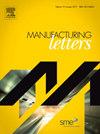Design of thermomechanical processes for tailored microstructures
IF 2
Q3 ENGINEERING, MANUFACTURING
引用次数: 0
Abstract
Thermomechanical processes enable tailoring of material properties and microstructures for advanced products. In medical technology, next-generation titanium implants require tailored material properties to improve health and quality of life. However, the interaction correlation between process parameters and material properties poses a major challenge for the design of thermomechanical manufacturing processes.
In this paper, we present a methodology for the design of thermomechanical processes to achieve tailored microstructural properties through forming technology and heat treatments. The methodology consists of five systematic steps to address the complexity of multiphysical coupling relationships between temperature, stress, microstructure and alloy composition, and to provide a guideline for effective implementation. It is applied to the production of nanostructured Ti-13Nb-13Zr (NanoTNZ) alloy for dental implants. The designed process of severe plastic deformation, recrystallization treatment and aging lead to nanostructured microstructures smaller than 200 nm. The resulting mechanical properties (UTS > 980 MPa, Young’s modulus of 73 GPa) meet the desired goals for improved biomedical implant-bone interactions. The tailored material properties and microstructures of NanoTNZ are therefore highly promising for use as an implant material.
The case study demonstrates the importance of a systematic method to manage the complexity of multiphysical coupling relationships in the design of thermomechanical processes to enable tailored microstructures for advanced materials and products.
设计用于定制微结构的热机械工艺
热机械工艺可为先进产品量身定制材料特性和微结构。在医疗技术领域,下一代钛植入物需要量身定制的材料特性,以改善健康和生活质量。然而,工艺参数与材料特性之间的相互作用关系对热机械制造工艺的设计构成了重大挑战。本文介绍了一种热机械工艺设计方法,通过成型技术和热处理实现量身定制的微观结构特性。该方法包括五个系统步骤,以解决温度、应力、微观结构和合金成分之间复杂的多物理耦合关系,并为有效实施提供指导。该方法被应用于生产用于牙科植入物的纳米结构 Ti-13Nb-13Zr (NanoTNZ) 合金。通过设计的剧烈塑性变形、再结晶处理和老化过程,形成了小于 200 nm 的纳米微结构。由此产生的机械性能(UTS > 980 MPa,杨氏模量 73 GPa)达到了改善生物医学植入物与骨相互作用的预期目标。该案例研究表明,在设计热机械过程时,必须采用系统的方法来管理多物理耦合关系的复杂性,从而为先进材料和产品量身定制微结构。
本文章由计算机程序翻译,如有差异,请以英文原文为准。
求助全文
约1分钟内获得全文
求助全文
来源期刊

Manufacturing Letters
Engineering-Industrial and Manufacturing Engineering
CiteScore
4.20
自引率
5.10%
发文量
192
审稿时长
60 days
 求助内容:
求助内容: 应助结果提醒方式:
应助结果提醒方式:


